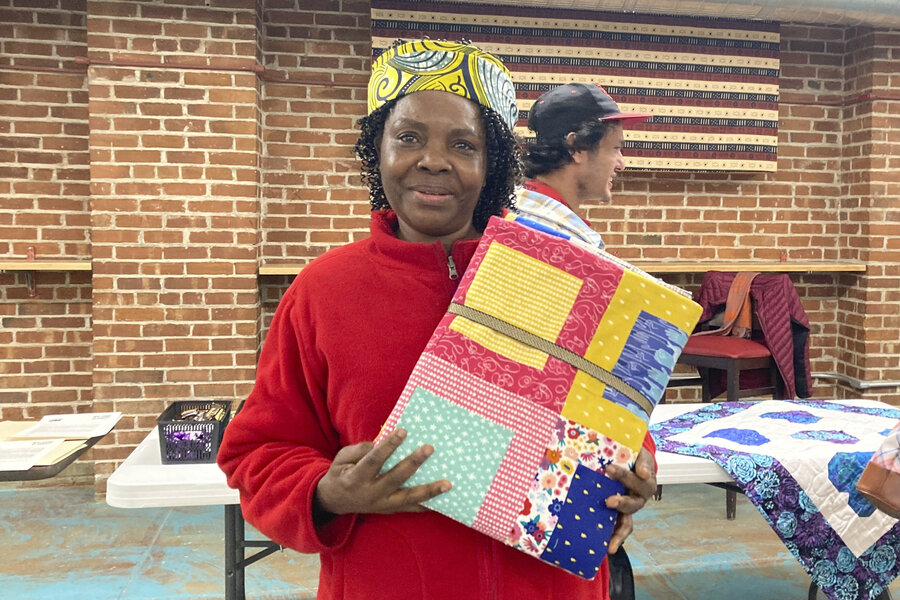Handmade blankets offer warm welcome to US refugees
Loading...
| Burlington, Vt.
“Welcome to the USA,” says a note attached to a hand-crocheted blanket of purple, white, and gray stripes.
Hollie Shaner-McRae, of Burlington, who made the blanket as a gift for a refugee, wrote of her great-grandparents coming to the United States from Ukraine, Russia, and Poland.
One great-grandfather was a tailor and the other was a barrel-maker, she wrote. “Both were so brave and came to America as teenagers,” she wrote in the note. “I hope you make friends and feel safe here,” Ms. Shaner-McRae wrote to whoever would receive the blanket. “Vermont is blessed to have new families arrive and enrich our world.”
The quilt was one of at least 86 artistic blankets that crafters sewed, crocheted, and knitted as gifts for refugees and immigrants to make them feel welcomed in their new community in Vermont. The handmade creations were on display at the Heritage Mill Museum in Winooski, Vermont, before they were given away to refugees last week.
The effort is part of the national Welcome Blanket project, which describes itself as a crowd-sourced artistic action supporting refugees settling in the U.S. Los Angeles activist Jayna Zweiman started Welcome Blanket in 2017 in opposition to Donald Trump’s candidacy speeches about building a wall between the U.S. and Mexico.
As a grandchild of refugees, she grew up with family stories of her grandfather seeing the Statue of Liberty. That monument decades later still made him feel welcomed, she said.
Just as the Statue of Liberty was seen as an inviting symbol for immigrants in the late 19th and early 20th centuries, Ms. Zweiman thought at the time: “What can we do in the 21st century as people are coming through these different ports to welcome them?”
To date, thousands of blankets and notes have been created around the country for exhibits including in Atlanta; Chicago; Los Angeles; and Winooski, Vermont. The blankets, accompanied with the personal notes from their creators, were then gifted to refugees at events, in welcome boxes, at their new housing, or through charity groups.
The project is geared toward refugees – people forced to leave their home or country to escape war, persecution, or natural disaster – including Ukrainians who escaped the Russian invasion of their home country. But the blankets have also gone to immigrants.
In Vermont, Aisha Bitini, who is originally from Congo, said that she loves the blanket she chose – a soft, crocheted piece made up of large squares of gold, maroon, off-white, and gray.
“I’m so blessed to have one of them,” she said, draping it over her shoulder. She picked it out at the blanket giveaway held last week at the Association of Africans Living in Vermont, or AALV.
The note that came with the blanket “feels so special,” Ms. Bitini said, adding that she thanks the person who made “this beautiful blanket” and that she will “cherish it forever.”
Kalyan Adhikari, who’s originally from Nepal, said the Vermont project was “such a kind and warm initiative.” He said it makes refugees feel welcome and a little bit more like they’re home.
“This makes my heart warm. I can’t thank them enough,” he said of the blanket-makers.
The immigrant-refugee story resonated with Sonia Savoulian, of Los Angeles, when in 2017 then-President Trump imposed a ban on travelers from certain majority-Muslim countries. Her ancestry is Armenian, and her family includes refugees and immigrants. She herself is an immigrant – and she also happens to make things with yarn.
The Welcome Blanket project combines a creative outlet with a product that would help newcomers to the U.S. “feel an embrace, a welcome, and an aspiration,” she said. Since making her first Welcome Blankets for an exhibit in Atlanta in 2018, she has made a total of about 50 such blankets.
Ms. Zweiman said she hopes the blanket-making for refugees will become an American tradition.
“I want this happening 50 years from now,” she said. “And I want a kid who took part in this ... when the next wave of xenophobia comes, to remember that he had actually physically made something for someone who was coming.”
This story was reported by The Associated Press.







